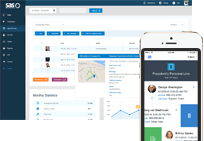- Log In
- Support
- Company
- Contact Us
- Live answers @ 1-888-532-4794
4 Ways to Audit Your Seasonal Tax Prep Answering Service

Tax season is here, which means accounting and tax prep firms are working diligently filing taxes, doling out financial advice, and answering the most important question – ‘So, how much am I getting back?’ Because this is a taxing time (pun intended) for both accountants and civilians alike, accountants often hire answering services like SAS for seasonal help answering calls. Virtual receptionist services like SAS can schedule appointments for new and existing clients, take messages, route important calls like calls from specific customers or callers with IRS issues, and answer questions like what forms should clients bring with them.
If your tax firm uses or is thinking about using an answering service to help with seasonal traffic, we’ve listed 4 quick ways to audit your service to make sure outsourcing is paying dividends both for your business, and for your clients.
#1. Make sure your service is live and updated.
First thing’s first. Make sure your answering service is live and ready to accept calls. If you’ve retained your answering service account in the off season in anticipation of forwarding to them during the tax blitz, you’ll want to place a test call to make sure the line is still active. Maybe you forgot to pay a bill and the line got deactivated. Maybe there was an oversight at the service and your account was cancelled. Just like you smell the milk before you pour it on your cereal, you’ll want to test the answering service line before you forward.
If you don’t have a service, don’t worry. The good news is you have no lines to test! The bad news is you have no one to answer your calls. But that’s going to change really quick when you sign up for a free trial.
If you cancel your account when tax season is over, give yourself some time to reactivate the account and run through your call handling protocols. SAS retains your call handling for up to a year after you leave service, but that isn’t true for every answering service. If your service doesn’t retain call handling, you’ll need to start from scratch, so definitely give yourself some time to get everything moving. Some questions you should be asking your seasonal answering service include:
- How long will my information stay saved?: If you only want to use your answering service during tax season, you will want to find out how long they can keep your information saved after you’ve left service. For example, SAS can keep deactivated scripts saved for about a year, but other answering services may wipe their systems after a month of inactivity. Using an answering service that can keep your information saved for at least a year would be helpful if you’re only planning on using them annually during tax season. Otherwise, it may be more trouble than it’s worth to keep going through the same process every year.
- Can I still access caller information and messages via my portal if my service is turned off?: If your answering service offers an online portal to retrieve messages, you may still be able to view information even when the account is not active. If you can’t access your information once the account is deactivated, you’ll want to make sure you send yourself all of the important data prior to cancelling.
- How long does it take to reactivate my account?: Each answering service is different, so this answer will vary. Some services can get you up and running in a matter of minutes, while others may need 48 hours or more. If your service has your script saved from last year, it shouldn’t take longer than a few minutes. However, if your information is no longer saved it will definitely take longer as your service will have to re-program the account.
- If I deactivate my account, will I lose my forwarding number?: Most answering services will not allow you to take your forwarding number with you should you decide to leave service, so it’s a real possibility that you will lose your number once you deactivate your account. However, depending on how long you are off service, it may be possible for you to retrieve your number when you reactivate your account, if it’s still available. If you’ve already spent money on advertising that number, you may want to consider dropping down to a lower plan during your off season instead of deactivating the account entirely to ensure you keep that number.
#2. Determine the reasons customers will be calling and prepare accordingly.
For outsourcing newbies, you’ll want to give some thought to your call handling. Call handling is what answering service agents will use to manage your calls, and if the handling isn’t 100%, your script can cause some trouble. We always recommend leveraging the experience of the service for guidance on what scripts will work, and which ones won’t. For example, protocols that you normally use in your office may not always work in a call center environment, so spending some time to get to know your new service will be beneficial for both you and your business.
A great script lets the answering service agents be nimble so they can handle most situations, and have a fail-safe for any situations they can’t. Some examples include:
- Calling to schedule an appointment: If your callers want to set an appointment, there are some follow up questions that could be helpful to ask. For example, are they ready to file and looking for an in person appointment? Do they need a phone appointment? Are they filing for an individual? A company? These questions can help streamline the process on your end, so you know who is coming in and when, and exactly what they need. The more information you have at your disposal, the easier it will be to get customers in and out as quickly and efficiently as possible.
- Calling for a Specific Person: Sometimes customers already have a specific employee they are working with or have worked with, and may be calling to speak directly to them. Answering service agents would be able to identify who the caller is asking for, and handle according to that staff member’s preference. For example, one staff member may just want all messages taken, while others could want calls transferred to them. If you have multiple staff members in your office, see how they want their calls handled and script accordingly. It’s also a great plan to have an ‘Any other staff member’ path if old customers are calling to speak to an employee who’s no longer employed.
- Calling from a Specific Company: As a tax prep firm, you may be helping companies with their taxes in addition to individuals, and you may want those calls handled differently. For example, an individual calling for help with their taxes could probably have a message taken, but you may want calls from companies transferred directly to you, as they’re going to be bringing in the big bucks.
- All Other Calls: If the caller’s query doesn’t fit into any of the categories you already have outlined, see if your answering service can set up a “catch all” for those miscellaneous calls that may trickle through. Usually these types of call paths have the agent gathering the caller’s name, number, email, and reason for call.
While these are just a few examples of how your call handling can be set up, most answering services can customize protocols based off of how you run things in your own office. Speaking to an intake specialist will help you determine the best course of action if you’re not sure where to start.
#3. Place test calls to make sure your systems are functioning properly.
Before forwarding your phones to the service, it’s a good idea to place a few mock calls to make sure things are operating smoothly. This will allow you to catch any errors first, which if left unattended, could give your business a bad look. The quicker you can iron out kinks, the quicker you can start getting back to work.
Pro tip: Even after going live with your customers, it doesn’t hurt to make a couple test calls here and there just to make sure everything is still running like a well-oiled machine.
#4. Make sure your clients know which number to call.
After you’ve made sure your service is active, updated, and you’ve ran through multiple tests, the final step is making sure your clients know which number to call. This can be done 1 of 2 ways:
- Call forwarding: Answering services use call forwarding to route your calls to the call center. They’ll provide a phone number specific to your account and you’ll use your phone’s pre-existing call forwarding feature to send traffic to the call center. Call forwarding is a feature that most phone providers offer, and can usually be turned off and on through the use of your phone’s keypad (like with *72 and *73). With call forwarding, you can control when calls go to your answering service and when they come to your own office.
- Advertising your number: Some businesses like to keep their own number separate from their answering service number. For example, they may want existing clients to call their office number directly, and they may want new client calls to go through their answering service. If this is the case for you and your business, advertising your answering service or forwarding number on your website and social media platforms is a good, usually free, way to go.
Pro tip: Most answering services won’t allow you to take the forwarding number with you should you decide to leave service, so it may not be cost effective in the long run for you to put the number on billboards, business cards, etc.
Categories
- Advice (32)
- Answering Service 101 (18)
- Best Practices (10)
- Call Center Jobs (6)
- Call Center Software (20)
- Comparison (2)
- Customer Service (30)
- Funny (31)
- Holidays (19)
- Industry Hacks (19)
- Infographics (53)
- International (1)
- Medical (8)
- News (12)
- Phone Etiquette (2)
- Phones (14)
- Pricing (8)
- Quizzes (3)
- Receptionist (11)
- SAS Products (29)
- Scripting (4)
- Services (5)
- Small Business (25)
- Starting Up (7)
- Tips and Tricks (19)
- Uncategorized (1)
- Videos (19)
- Workplace (6)
Recently writen
- Call Center Script Best Practices: Advanced Script Block Tips to Optimize Your Answering Service
- January 2025 Release Notes – Adjustments to Call Details Timeline, New Scripting Updates, Live Transcription, and more!
- April 2024 Release Notes – Voicemail Greetings, Ability to Access Websites With a Username and Password, and more!
- March 2024 Release Notes – New Add-On, Settings Revamp, and more!
Follow Us
How about a demo?
We'll show you how our web portal works and answer any questions you have about SAS.
Schedule a demo







